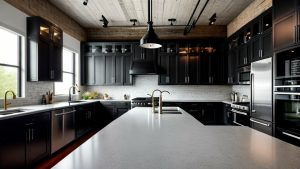If you’re hoping to renovate your kitchen but are looking to save money, then installing your own cabinets might be the perfect solution. Not only will you get the satisfaction of completing a DIY project, but you’ll also save a lot of money in the process. With our step-by-step guide, you’ll be able to install your own kitchen cabinets in no time.
Key Takeaways:
- Installing your own kitchen cabinets can be a cost-effective solution for a kitchen renovation project.
- Our step-by-step guide will help you successfully install your own cabinets.
- By self-installing kitchen cabinets, you can save money and feel a sense of accomplishment.
Gathering the Necessary Tools and Materials
Before jumping into installing your own kitchen cabinets, it’s important to gather all the necessary tools and materials. Being prepared beforehand will save you time and headaches during the installation process.
Some essential tools you’ll need include a measuring tape, screwdrivers, a level, and a drill. You may also need a jigsaw or circular saw for cutting any necessary pieces.
When it comes to materials, make sure you have the cabinets themselves and any necessary hardware, such as screws and brackets. It’s also important to consider any additional materials you may need, such as shims or filler strips for adjusting the cabinet positions.
To ensure a successful DIY cabinet installation, it’s important to have everything on hand before starting the project. This will help you avoid any last-minute trips to the hardware store and keep the momentum going once you begin.
Measuring and Planning the Cabinet Layout
Before installing your kitchen cabinets, it is essential to take accurate measurements and plan the layout. A well-planned layout will ensure that your cabinets fit properly and maximize the available space in your kitchen.
Step-by-step instructions for measuring and planning your cabinet layout:
- Remove any existing cabinets or fixtures that may interfere with your new cabinets.
- Measure the length and height of your walls to determine the available space for your cabinets.
- Mark the layout of your cabinets on the wall using a pencil. Start by marking the height of your base cabinets, typically 34-1/2 inches from the floor.
- Using a level, make a horizontal line across the wall to ensure that your base cabinets will be level.
- Measure and mark the locations of any appliances, such as your range or refrigerator, to ensure that your cabinets align properly with them.
- Repeat the process for your upper cabinets, starting with a horizontal line at the appropriate height (typically 54-60 inches from the floor) and marking the location of any appliances, windows, or other obstacles.
- Double-check your measurements and layout to ensure accuracy before proceeding with installation.
Proper planning and measuring will save you time and frustration during the installation process. By following these steps, you will have a solid foundation for a successful installation of your kitchen cabinets.
Prepping the Kitchen Space
Before you begin installing your new cabinets, it is important to properly prep your kitchen space. This will ensure a smooth installation process and prevent any damage to your floors and countertops. Follow these cabinet installation tips to prepare your kitchen:
- Remove any existing cabinets or shelves in the area where you’ll be installing the new cabinets. Take care to disconnect any plumbing or electrical connections to avoid accidents.
- Clear the area and ensure there is enough space to work around. This includes removing any furniture, appliances, and decorations that may obstruct the installation.
- Clean the walls and ceiling to ensure they are ready for the installation. Remove any debris, grease, or dirt that may affect the stability and adhesion of the cabinets.
- Protect your floors and countertops. Cover them with drop cloths, tarps, or cardboard to prevent scratches, spills, or damage from tools. You can also use foam mats or carpet tiles to provide a cushioned surface for kneeling and standing.
- Confirm that your walls are level. Use a level to check for any bumps or slopes that may affect the alignment of the cabinets. You may need to use shims to adjust the cabinets and ensure they are level.
By following these self-installing kitchen cabinet tips, you’ll be ready to start the installation process with ease and confidence.
Assembling the Cabinets
Before the installation process can begin, the cabinets must be assembled. Most cabinets come in flat-pack form and require assembly before they can be installed. Follow these step-by-step instructions for a successful cabinet assembly:
- Clear a workspace that is clean and well-lit.
- Lay out all the pieces and hardware in an organized manner.
- Read the instructions carefully before starting assembly.
- Assemble the sides of the cabinet and attach the back panel.
- Attach the top and bottom panels.
- Add the shelves and attach the doors.
- Check for proper alignment and levelness.
Be sure to take your time during the assembly process and follow all instructions carefully. Double-check all connections and ensure that the cabinet is secure before proceeding with installation.
Installing the Upper Cabinets
Now that the wall cabinets have been assembled and prepped, it’s time to hang them. Follow these step-by-step instructions to ensure successful installation:
- Locate the studs in the wall and mark them with a pencil.
- Using a level, draw a horizontal line where the bottom of the cabinet will be placed.
- Attach a ledger board to the wall along the line for support during installation.
- Have a helper hold the cabinet in place on the ledger board while you secure it to the wall with screws.
- Check for levelness and adjust accordingly before securing the cabinet to the wall and adjacent cabinets.
- Repeat the process for the remaining wall cabinets, ensuring alignment and levelness with the previously installed cabinets.
When installing upper cabinets, it’s essential to use brackets for added stability. Always follow the manufacturer’s instructions regarding weight limits and placement of the brackets. Additionally, make sure to avoid over-tightening screws as this can damage the cabinet and compromise its strength.
Pro Tip: Use shims to fill gaps between the wall and the cabinet to ensure a snug fit and prevent any sagging.
By following these cabinet installation tips, you can have beautiful and functional upper cabinets installed in your kitchen with ease.
Installing the Base Cabinets
Once the upper cabinets are securely hung on the wall, it’s time to move onto the base cabinets. It’s important to ensure that the base cabinets are levelled and securely attached to the wall before proceeding. Here are some step-by-step instructions to help you install your base cabinets:
- Start by measuring and marking the height for the base cabinets. Use a level to ensure that the markings are accurate.
- Place the first base cabinet on the marks and adjust the legs to level it. Use shims to fill any gaps between the cabinet and the wall.
- Attach the cabinet to the wall using screws and wall brackets. Be sure to screw through a solid part of the cabinet frame.
- Repeat the process for the remaining base cabinets, making sure they are levelled and securely attached to the wall.
- Adjust the cabinets as needed to ensure they are properly aligned with the upper cabinets.
- Once the base cabinets are securely attached, add any necessary finishing touches such as toe kicks or trim.
It’s important to make sure that the base cabinets are levelled and securely attached to the wall to prevent any accidents or damage to the cabinets. Adjust the cabinets as needed and take your time to ensure a successful installation. In the next section, we’ll discuss adding finishing touches to complete the installation.
Adding Finishing Touches
Now that the cabinets are installed, it’s time to add the finishing touches that will give them that polished, professional look. Here are some tips to help you get started:
Install Hardware
Adding hardware such as handles, knobs, or hinges to your cabinets can make a big difference in their appearance. When selecting hardware, make sure it complements the style of your cabinets and matches the finish of your appliances and fixtures. Installing hardware can be a simple DIY project, but make sure to measure carefully and use the right tools to ensure a clean and secure installation.
Add Trim
Trim can be used to cover gaps between cabinets and walls or to add decorative accents to the cabinets themselves. There are many different types of trim to choose from, such as crown molding, toe kick trim, or light rail molding. When selecting trim, consider the style of your cabinets and the overall look you want to achieve. Installing trim can be a bit more challenging than adding hardware, so make sure to measure carefully and use a level to ensure a smooth and even installation.
Fill Gaps
Even with careful measurement and installation, there may be small gaps between cabinets or between cabinets and walls that need to be filled. To fill gaps, use wood filler or caulk that matches the color of your cabinets. Apply the filler with a putty knife or caulk gun, making sure to smooth it out and wipe away any excess. Allow the filler to dry completely before sanding or painting.
These finishing touches may seem small, but they can make a big difference in the overall look and feel of your kitchen. By taking the time to add hardware, trim, and fill gaps, you can create a beautiful, cohesive space that you’ll love spending time in.
Testing and Adjusting the Cabinets
Before considering the kitchen cabinet installation complete, it’s crucial to perform thorough testing and adjustments. This step ensures that the cabinets are level, secure, and functional for everyday use.
Start by checking the levelness of the cabinets. A simple bubble level can help you determine if the cabinets are uneven, and adjustments can be made by adding shims under the cabinets to level them out.
Next, test the doors and drawers to ensure that they open and close smoothly. If the doors or drawers are misaligned, they may need to be adjusted. This can be done by tightening or loosening the screws on the hinges or drawer slides until the doors or drawers are flush with the cabinet.
Once the doors and drawers are adjusted, test any additional features such as lazy susans or pull-out shelves to ensure they work correctly.
If any issues arise during testing, don’t hesitate to make adjustments until the cabinets are fully functional. It’s better to take the time to make sure everything is working correctly now rather than having to go back later to fix problems.
A thorough testing and adjustment process will ensure the kitchen cabinets are ready for use and prevent any potential issues down the line.
Cleaning Up and Caring for Your Cabinets
After successfully installing your own kitchen cabinets, it’s important to care for them properly to maintain their beauty and functionality for years to come. Here are some tips to help you keep your cabinets in top condition:
- Regularly dust and wipe down the cabinets with a soft, damp cloth. Avoid using abrasive or harsh cleaners that could damage the finish.
- To remove stubborn stains or grease, use a gentle cleaner specifically designed for wood cabinets and follow the manufacturer’s instructions
- Avoid exposing the cabinets to excessive moisture or heat, which can cause warping or damage.
- Be cautious when using sharp objects on or near the cabinets, as they can scratch or dent the surface.
- Keep the cabinets dry and well-ventilated to prevent the growth of mold or mildew.
- Check and tighten hardware regularly to ensure proper functionality and prevent loosening.
By following these simple care tips, you can keep your cabinets looking great and functioning properly for years to come.
Troubleshooting Common Issues
Installing your own kitchen cabinets can be a rewarding DIY project, but it’s not without its challenges. Here are some common issues you may encounter during the installation process and how to troubleshoot them.
Misaligned Cabinets
If your cabinets are misaligned, it’s usually because they weren’t properly leveled during installation. To fix this, use a level to check the cabinets and adjust the legs or shims as necessary. Once the cabinets are level, check that they’re properly screwed into the wall studs for added stability.
Loose Screws
Over time, screws can come loose, causing your cabinets to wobble or even fall off the wall. To fix this, remove the affected screws and replace them with longer screws that will reach the wall studs. Be sure to use a drill or screw gun for added torque, but be careful not to over-tighten and strip the screws.
Uneven Doors
Uneven cabinet doors are a common issue that can be caused by several factors, including misaligned hinges or warped doors. To fix this, adjust the hinges using a screwdriver to align the doors properly. Check that the hinges are firmly attached to the cabinet and the door for added stability. If the doors are warped, you may need to replace them or try using shims to level them out.
Stuck Drawers
If your cabinet drawers are sticking or difficult to open, it may be because they’re misaligned or the tracks are dirty. To fix this, remove the drawers and clean the tracks with a soft cloth or brush. Check that they’re properly aligned and adjust the tracks or drawer slides as necessary. Lubricate the tracks with paraffin wax or furniture polish to ensure smooth operation.
Uneven Countertops
Uneven countertops can be caused by misaligned cabinets or uneven walls. To fix this, first check that your cabinets are level and properly secured to the wall studs. Then, use a level to check the countertop and shim any low spots as necessary. If the walls are uneven, you may need to use a belt sander or joint compound to even them out before installing the cabinets.
By troubleshooting common issues during your kitchen cabinet installation process, you can ensure a successful and hassle-free project. Following the step-by-step guide and taking the time to troubleshoot any issues will help you create a beautiful and functional kitchen that you can be proud of.
Conclusion
Installing your own kitchen cabinets can be a rewarding and cost-effective DIY project. By following our step-by-step kitchen cabinet installation guide, you can create a beautiful and functional space with your own hands.
Remember to gather all the necessary tools and materials before starting, carefully plan your layout and measurements, and take precautions to protect your kitchen during installation. Assemble the cabinets correctly and securely attach them to the wall, adjusting for levelness and stability. Don’t forget the finishing touches, such as adding trim and hardware for a polished look.
Thoroughly test and adjust your cabinets for smooth functionality, and then enjoy your new space. With proper care and maintenance, your DIY kitchen cabinets will last for years to come.
Taking the Next Step
If you’re feeling confident and excited to start your kitchen cabinet installation journey, gather your tools and materials and get started. And if any issues arise, refer back to our troubleshooting tips for guidance.
Thank you for choosing our kitchen cabinet installation tutorial as your guide. We wish you the best of luck on your DIY project!
FAQ
Q: What are the benefits of installing my own kitchen cabinets?
A: Installing your own kitchen cabinets allows you to save money on professional installation costs and gives you complete control over the design and layout of your kitchen.
Q: What tools and materials do I need for DIY kitchen cabinet installation?
A: Some essential tools and materials for DIY kitchen cabinet installation include a measuring tape, screwdrivers, a level, and of course, the cabinets themselves.
Q: How do I measure and plan the layout for the cabinets?
A: To measure and plan the layout for the cabinets, start by measuring your kitchen space and marking the wall. Then, determine the positions of the cabinets for optimal functionality and aesthetics.
Q: What preparations should I make before installing the cabinets?
A: Before installing the cabinets, it’s important to remove existing cabinets, clear the area, and ensure that the walls are ready for installation. Remember to protect the floors and countertops during the process as well.
Q: How do I assemble the cabinets?
A: If your cabinets come in flat-pack form, follow the step-by-step guide provided to assemble them correctly. Pay attention to the instructions, tips, and precautions to ensure a successful assembly.
Q: How do I install the upper cabinets?
A: To install the upper cabinets, securely hang them on the wall, ensuring they are level and properly attached. You can use brackets and studs for added stability.
Q: How do I install the base cabinets?
A: When installing the base cabinets, make sure they are leveled and properly aligned with the upper cabinets. Attach them securely to the wall and adjust and secure them for stability.
Q: What are the finishing touches I should add?
A: Adding finishing touches to your cabinets includes installing trim, filling gaps, and adding hardware such as handles, knobs, and hinges for a polished look.
Q: How do I test and adjust the installed cabinets?
A: Test the installed cabinets for levelness, adjust doors and drawers as needed, and ensure smooth functionality. Thoroughly test the cabinets to ensure they meet your expectations.
Q: How do I clean and care for my cabinets?
A: Clean your cabinets using proper techniques and recommended products. Additionally, establish a routine maintenance practice to keep the cabinets looking their best.
Q: What should I do if I encounter common issues during installation?
A: If you encounter common issues such as misalignment, loose screws, or uneven doors, follow the troubleshooting tips provided to overcome these obstacles and successfully complete the installation.
Q: What are the key takeaways from this guide?
A: This guide provides step-by-step instructions and tips for DIY kitchen cabinet installation. It empowers readers to confidently embark on their own installation journey, saving money and creating their dream kitchen within a budget.

It’s me, Amber Hayden, the heart and soul behind SagarmathaOnlineMedia.com. From a young age, I’ve been head over heels for everything home-related, from interior decor to gardening. I’m the type who can’t resist a well-crafted piece of furniture, and I firmly believe that a home isn’t complete without a pet or two. But it’s not just about creating pretty spaces for me. I’m all about making homes that tell a story reflecting the people living there. SagarmathaOnlineMedia.com is my way of sharing this passion with you. Whether you’re looking for tips to jazz up your living room, advice on pet care, or ideas to make your garden bloom, I’m here to help. So, let’s embark on this journey together and make your house a home!



